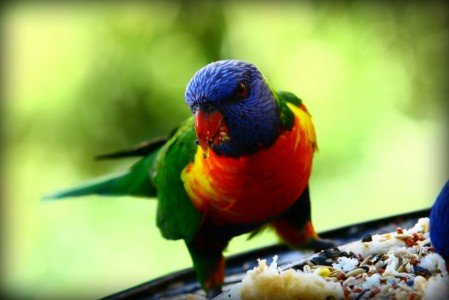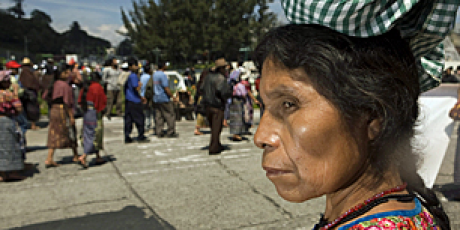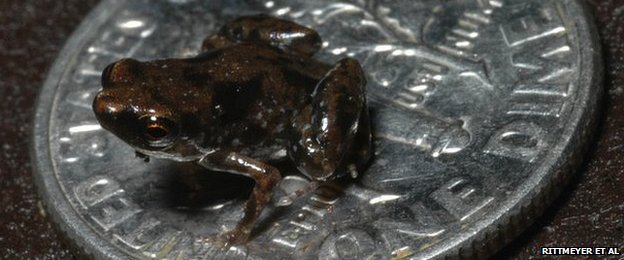Home Tags Posts tagged with "papua new guinea"
papua new guinea
Kepari Leniata, a 20-year-old woman from Papua New Guinea, has been tortured and burned alive after being accused of using sorcery to kill a young boy, local media report.
Kepari Leniata was stripped, tied up and doused in petrol by the boy’s relatives in Mount Hagen in the Western Highlands, said the National newspaper.
She was then thrown onto a fire in front of hundreds of people.
Police and firefighters were unable to intervene, the paper said.
The Post Courier newspaper said they had been outnumbered by the crowd and chased away. Both newspapers published graphic photos of the incident on their front pages.
Provincial police commander Supt Kaiglo Ambane told the National that police were treating the case as murder and would arrest those responsible.
In parts of the Pacific nation deaths and mysterious illnesses are sometimes blamed on suspected sorcerers. Several reports have emerged in recent years of accused people, usually women, being killed.

Kepari Leniata, a 20-year-old woman from Papua New Guinea, has been tortured and burned alive after being accused of using sorcery to kill a young boy
In 2009, after a string of such killings, the chairman of PNG’s Constitutional Review and Law Reform Commission said defendants were using accusations of witchcraft as an excuse to kill people, and called for tougher legislation to tackle the issue.
Local Christian bishop David Piso told the National that sorcery-related killings were a growing problem, and urged the government to “to come up with a law to stop such practice”.
The US embassy in the capital, Port Moresby, condemned the killing as a “brutal murder”, the AFP news agency reports, and evidence of “pervasive gender-based violence” in Papua New Guinea.
“There is no possible justification for this sort of violence. We hope that appropriate resources are devoted to identifying, prosecuting, and punishing those responsible for Ms Leniata’s murder.”
Prince Charles and the Duchess of Cornwall have been given a glimpse of village life in Papua New Guinea.
A choir of women in floral shirts and grass skirts welcomed the couple, who are on a tour to mark the Queen’s Diamond Jubilee year, to Boera.
The Prince of Wales and the duchess of Cornwall were shown crafts, canoe building and an aid project before a state dinner in capital Port Moresby.
Prince Charles, colonel-in-chief of the local Royal Pacific Islands Regiment, earlier inspected a military parade.
Dressed in the forest green uniform of the regiment, he presented infantrymen with new colors at the Sir John Guise Stadium in Port Moresby.
In a speech, he introduced himself in the local Tok Pisin language as the “first child of Mrs. Queen”, which brought cheers and applause from the crowd of about 5,000 people.
His words translated as: “I bring you greetings from Her Majesty the Queen of Papua New Guinea and from all my family members during this celebration of the Diamond Jubilee.”

Prince Charles and the Duchess of Cornwall have been given a glimpse of village life in Papua New Guinea
The event also included an open-air church service, in which prayers were said for the Queen, while the local culture was showcased in dance and music.
Tribes from across Papua New Guinea were present, including Huli men with their yellow painted faces and Asaro mudmen, with large false heads and bodies covered in grey clay.
The royal couple arrived on the island on Saturday on the first leg of a two-week tour of Commonwealth countries, which will also see them visit Australia and New Zealand.
It is the fourth time Prince Charles has visited Papua New Guinea but the first time for Camilla.
During a visit to the National Bird of Paradise and Orchid Garden, the Duchess of Cornwall was presented with a rare hybrid orchid named in her honor, the Dendrobium Camilla.
At Boera village, hundreds of residents turned out to greet Prince Charles and the duchess.
Jenny Lohia, 24, topless and dressed traditionally in a leaf skirt and body paintings, gave Camilla a peck on the cheek as she placed a necklace of shells around her neck as a welcoming present.
They royal couple were shown local painting, weaving and pottery and toured the aid project concerned with the replanting of coastal mangroves.
The couple were guests of honor at the state dinner later, which was hosted by governor general Sir Michael Ogio and his wife.
[youtube e8yF6LV4Xs4]
[youtube N8_xHuBOfHo]
Australian lower house has approved laws allowing offshore processing camps for asylum seekers to be re-established in Papua New Guinea and Nauru.
The MPs passed a bill presented to parliament on Tuesday, following recommendations from an expert panel.
The bill now goes to the Senate, where it is expected to pass in coming days because both the governing Labor Party and the opposition back it.
Labor, under former Prime Minister Kevin Rudd, closed the camps in 2008.
The debate on the legislation in the lower house lasted for six hours on Tuesday and continued the next day. Only two MPs – an independent and one from the Australian Greens party – voted against the bill.
Immigration Minister Chris Bowen, speaking before the vote, said it was important that the bill pass.
“The Australian people expect no less and the people smugglers fear nothing more,” he said.
Prime Minister Julia Gillard – whose party had until Monday opposed the move – said on Tuesday that she hoped processing centres for asylum seekers could be reopened “within a month”.
The vote followed the release on Monday of a report by an expert panel appointed by Julia Gillard to break the deadlock on the issue of asylum.
It set out 22 recommendations aimed at tackling people-smuggling issues, including re-opening mothballed offshore processing centres.

Australian lower house has approved laws allowing offshore processing camps for asylum seekers to be re-established in Papua New Guinea and Nauru
The move comes amid rising numbers of asylum seekers travelling to Australia by boat from Indonesia.
Officials reported that at least three boats carrying more than 150 people were intercepted on Tuesday.
Australian officials say offshore processing is needed as a deterrent against making the perilous journey – pointing out that many lives have been lost in sinkings in recent years.
But critics say the policy – known as the Pacific Solution before it was scrapped in 2008 – violates asylum seekers’ rights.
In the past detainees on Nauru mounted multiple hunger strikes to protest against both conditions and the length of their detention.
Small protests against offshore processing have been reported outside immigration offices in Sydney and Melbourne.
Melissa Park, a Labor MP, earlier said that the measures being debated were “at the lower end of what we are capable of as a nation”.
“There are strong concerns about the devastating consequences, including severe mental health issues of detention of asylum seekers for indeterminate periods on Nauru and Manus Island,” she said.
The Pacific Solution was introduced in 2001 by the government of John Howard, in response to a reported rise in the number of asylum seekers arriving by boat.
Processing centres were set up on Nauru and on Manus Island in Papua New Guinea, the governments of the two nations receiving millions of dollars in aid in exchange.
The Australian navy diverted all boats carrying asylum seekers to those camps, where many were detained for months – sometimes years – under high security.
Many Australians did support the policy but rights groups condemned it and accused Australia of failing to meet its obligations under refugee conventions.
Australia asylum:
• In 2010, there were 6,535 Irregular Maritime Arrivals (IMAs – people coming by sea) in 134 vessels
• In 2011, 4,565 IMAs arrived in 69 vessels
• As of 13 August 2012, 7,629 IMAs had arrived in 114 boats
• To date, July has been the busiest month, with 1,798 IMAs
• Most of the IMAs from 2009-2011 came from Afghanistan, Sri Lanka and Iran
• Some asylum-seekers arrive by plane. Between July 2010 and June 2011, 6,316 people applied in this way
Source: Australian Department of Immigration and Citizenship
Pacific Solution
• Established in 2001 under conservative government of John Howard
• Asylum seekers arriving by boat detained in offshore centres in PNG and Nauru
• Rights groups criticized the conditions in which people were held, as detainees went on repeated hunger strikes
• Labor’s Kevin Rudd elected in November 2007, said Pacific Solution would end
• Last detainees left Nauru in February 2008
Wildlife trade watchdog Traffic has found that the Solomon Islands has become a hub for “laundering” wild birds into the global captive-bred bird trade.
Thousands of parrots, cockatoos and other exotic birds have been exported over the last 10 years, Traffic has reported.
But officials say there are no major captive breeding units in the islands.
The Solomons recently joined Convention on International Trade in Endangered Species (CITES), the global wildlife trade convention, which sets different conditions for trading captive-bred and wild animals.
“Declaring exported birds as being captive-bred has all the hallmarks of a scam to get around international trade regulations,” said Chris Shepherd, Traffic’s deputy director for Southeast Asia.

Traffic has found that the Solomon Islands has become a hub for "laundering" wild birds into the global captive-bred bird trade
Some of the 35 bird species exported from the Solomons are on the internationally recognized Red List of Threatened Species.
They include the Critically Endangered yellow-crested cockatoo (Cacatua sulphurea), and the chattering lory (Lorius garrulus) and blue bird of paradise (Paradisaea rudolphi), which are both categorized as Vulnerable.
Under CITES all trade in the yellow-crested cockatoo is banned.
For the others, exports of wild-caught birds are strictly regulated.
Using records from importing countries, Traffic investigators calculated that about 54,000 birds were exported from the Solomons in the period 2000-2010.
More than 40,000 of these were declared as captive-bred.
Most belong to species native to the Solomons, but more than 13,000 came from non-native species, mainly originating in Indonesia and Papua New Guinea.
But Traffic could find no records of these species being imported into the Solomons, either for re-export or to begin a captive breeding programme.
An official from the government’s Environment Conservation Division told investigators: “There are no breeding facilities, only some confusion with storing facilities.
“Most of the exported birds were captured and kept in holding sites only.”
The main destinations for the birds were Malaysia and Singapore.
Malaysia recently suspended imports from the Solomon Islands after concerns were raised. Traffic is urging the Singapore government to do the same.
It also recommends that CITES should investigate the situation with authorities in the Solomon Islands, and consider a trade suspension if no action is taken.
Traffic is jointly supported by the International Union for the Conservation of Nature (IUCN) and WWF, and works with CITES on various issues.

Dear friends,
When security forces of a Canadian mining company brutally evicted Mayan families from their villages in Guatemala, eleven women were raped, a community leader was killed, and a young man paralyzed. Now villagers are standing up and suing HudBay Minerals for these horrific crimes — but they need our help to match the corporate legal firepower and win their case!
The victims have filed a lawsuit in Canada, where HudBay’s headquarters are located. But HudBay is asking that the court turn over the lawsuit to Guatemala, where its weak courts are likely to let them go free. Experts say that the ruling could have massive reverberations beyond Canadian borders — a win for the plaintiffs could force HudBay and other multinationals to clean up their acts abroad.
The court hearing is happening now and the plaintiffs need our help to cover the legal costs — if we raise enough funds, we can give these villagers the same legal firepower as HudBay’s corporate machine, achieve justice for the victims, and continue campaigning to protect human rights over profits around the world. Click on the link below to chip in. If just 20,000 of us donate today, we could help end these mining murders for good by setting a key legal precedent:
https://secure.avaaz.org/en/stop_murder_and_rape_for_profit/
Multinational companies are responsible for some of the most terrible crimes all over the world but shockingly, corporate abuses often go unpunished. In mining alone, corporate giants like Rio Tinto and Barrick Gold are accused of a wide range of atrocities that include environmental destruction, brutal gang rapes, and even thousands of deaths — from Tanzania to Papua New Guinea. Winning this case could begin to put corporate wrongdoing in check.
Companies like HudBay can often act with impunity because they think their countries’ courts won’t police the crimes they commit overseas. Or they set up shell corporations designed to protect their headquarters from liability. If we win this case, it could set a precedent that can help stop rapes, save entire villages, and protect fragile ecosystems — no matter where these companies operate.
These firms have millions of dollars and will do whatever it takes to win this and similar cases because they know it’s a game changer. Giving just a small amount will help in the fight to bring them to justice. Click here to help:
https://secure.avaaz.org/en/stop_murder_and_rape_for_profit/
Courts are supposed to be places where people go to get justice. But all too often, corporate interests have made them the bastions of the rich and powerful. We have taken on deep rooted corruption before and won. Now let’s stand with and empower these victims and help create a world where no one is above the law.
With hope and determination,
Emma, Jamie, Pascal, Ari, Ricken, Maria Paz, Diego and the whole Avaaz team

Sources
Widow files $12M suit against mining company (CBC)
http://www.cbc.ca/news/world/story/2010/12/02/mining-lawsuit002.html
Guatemalan lawsuits to continue against HudBay, says lawyer (Mining Weekly)
http://www.miningweekly.com/article/lawsuits-against-hudbay-over-guatemalan-project-to-continue-says-lawyer-2011-08-10
Lawsuits against Canadian company HudBay Minerals Inc. over human rights abuse in Guatemala (Klippensteins)
http://www.chocversushudbay.com/
Award Winning Mining Company Being Sued for Violent Death of Community Leader: Industry Out of Step with Canadian Values and Expectations (Mining Watch Canada)
http://www.miningwatch.ca/fr/node/6609
U.S. court revives human rights case against Rio Tinto (Financial Post)
http://business.financialpost.com/2011/10/25/u-s-court-revives-human-rights-case-against-rio-tinto/
Claims of sexual abuses in Tanzania blow to Barrick Gold (Globe and Mail)
http://www.theglobeandmail.com/news/world/africa-mideast/claims-of-sexual-abuses-in-tanzania-blow-to-barrick-gold/article2040735/

About Avaaz.org:
Avaaz.org is a 13-million-person global campaign network that works to ensure that the views and values of the world’s people shape global decision-making. (“Avaaz” means “voice” or “song” in many languages.) Avaaz members live in every nation of the world; our team is spread across 13 countries on 4 continents and operates in 14 languages. Learn about some of Avaaz’s biggest campaigns here, or follow us on Facebook or Twitter.
The world’s smallest frog has been discovered in Papua New Guinea by a US-based team.
At 7 mm (0.27 inches) long, Paedophryne amauensis may be the world’s smallest vertebrate – the group that includes mammals, fish, birds and amphibians.
The researchers also found a slightly larger relative, Paedophryne swiftorum.
Presenting the new species in PLoS One journal, the researchers suggest the frogs’ tiny scale is linked to their habitat, in leaf litter on the forest floor
Finding the frogs was not an easy assignment.

The world’s smallest frog is pictured on a US dime, whose diameter is 18mm
The frogs are well camouflaged among leaves on the forest floor, and have evolved calls resembling those of insects, making them hard to spot.
“The New Guinea forests are incredibly loud at night; and we were trying to record frog calls in the forest, and we were curious as to what these other sounds were,” said research leader Chris Austin from Louisiana State University in Baton Rouge, US.
“So we triangulated to where these calls were coming from, and looked through the leaf litter.
“It was night, these things are incredibly small; so what we did after several frustrating attempts was to grab a whole handful of leaf litter and throw it inside a clear plastic bag.
“When we did so, we saw these incredibly tiny frogs hopping around,” he said.
The Paedophryne genus was identified only recently, and consists of a number of tiny species found at various points in the eastern forests of Papua New Guinea.
“They’re occupying the relatively thick leaf litter of tropical forest in low-lying parts of the island, eating incredibly small insects that typically are much smaller than insects that frogs eat,” said Professor Chris Austin.
“And they’re probably prey for a large number of relatively small invertebrates that don’t usually prey on frogs.”
Predators may well include scorpions.
Intriguingly, other places in the world that also feature dense, moist leaf litter tend to possess such small frog species, indicating that amphibians are well placed to occupy this ecological niche.
Before the Paedophrynes were found, the title of “world’s smallest frog” was bestowed on the Brazilian gold frog (Brachycephalus didactylus) and its slightly larger Cuban relative, the Monte Iberia Eleuth (Eleutherodactylus iberia). They both measure less than 1 cm long.
The smallest vertebrates have until now been fish.
Adult Paedocypris progenetica, which dwells in Indonesian swamps and streams, measures 7.9-10.3 mm long.
Male anglerfish of the species Photocorynus spiniceps are just over 6 mm long. But they spend their lives fused to the much larger (50 mm long) females, so whether they should count in this contest would be disputed.
Paedophryne amaunensis adults average 7.7 mm, which is why its discoverers believe it how holds the crown.
The remote expanses of Papua New Guinea rank alongside those of Madagascar as places where hitherto undiscovered amphibian species are expected to turn up, as they are largely undeveloped and not well explored.








